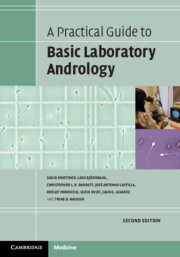Book contents
- A Practical Guide to Basic Laboratory Andrology
- A Practical Guide to Basic Laboratory Andrology
- Copyright page
- Contents
- Abbreviations
- Chapter 1 Introduction
- Chapter 2 Basic Physiology
- Chapter 3 Basic Semen Examination
- Chapter 4 Extended Semen Analysis
- Chapter 5 Sperm DNA
- Chapter 6 Computer-Aided Sperm Analysis
- Chapter 7 Sperm Function Tests
- Chapter 8 Tests of Sperm-Cervical Mucus Interaction
- Chapter 9 Sperm Preparation
- Chapter 10 Sperm Cryopreservation
- Chapter 11 Preparation of Surgically Retrieved Spermatozoa
- Chapter 12 Quality Management and Accreditation
- Chapter 13 Risk Management
- Chapter 14 Reproductive Toxicology
- Chapter 15 Andrology Laboratory Safety
- Book part
- Index
- References
Chapter 8 - Tests of Sperm-Cervical Mucus Interaction
Published online by Cambridge University Press: 16 February 2022
- A Practical Guide to Basic Laboratory Andrology
- A Practical Guide to Basic Laboratory Andrology
- Copyright page
- Contents
- Abbreviations
- Chapter 1 Introduction
- Chapter 2 Basic Physiology
- Chapter 3 Basic Semen Examination
- Chapter 4 Extended Semen Analysis
- Chapter 5 Sperm DNA
- Chapter 6 Computer-Aided Sperm Analysis
- Chapter 7 Sperm Function Tests
- Chapter 8 Tests of Sperm-Cervical Mucus Interaction
- Chapter 9 Sperm Preparation
- Chapter 10 Sperm Cryopreservation
- Chapter 11 Preparation of Surgically Retrieved Spermatozoa
- Chapter 12 Quality Management and Accreditation
- Chapter 13 Risk Management
- Chapter 14 Reproductive Toxicology
- Chapter 15 Andrology Laboratory Safety
- Book part
- Index
- References
Summary
Sampling of cervical mucus, its assessment, and the investigation of sperm-mucus interaction are described in detail. Methods are provided for a range of common tests that are structured as standard operating procedures (SOPs) for easy use at the bench. Methods are focussed on objectivity, robustness, standardized reporting, controlling the risk of errors, and minimizing measurement uncertainty. Includes the post-coital test, Kurzrok-Miller slide test, the Kremer capillary tube sperm penetration test, and the sperm-cervical mucus contact sldie test. An explanation of crosed hostility testing is also included, along with a discussion of complementary tests and the use of cervical mucus surrogates.
- Type
- Chapter
- Information
- A Practical Guide to Basic Laboratory Andrology , pp. 175 - 193Publisher: Cambridge University PressPrint publication year: 2022



